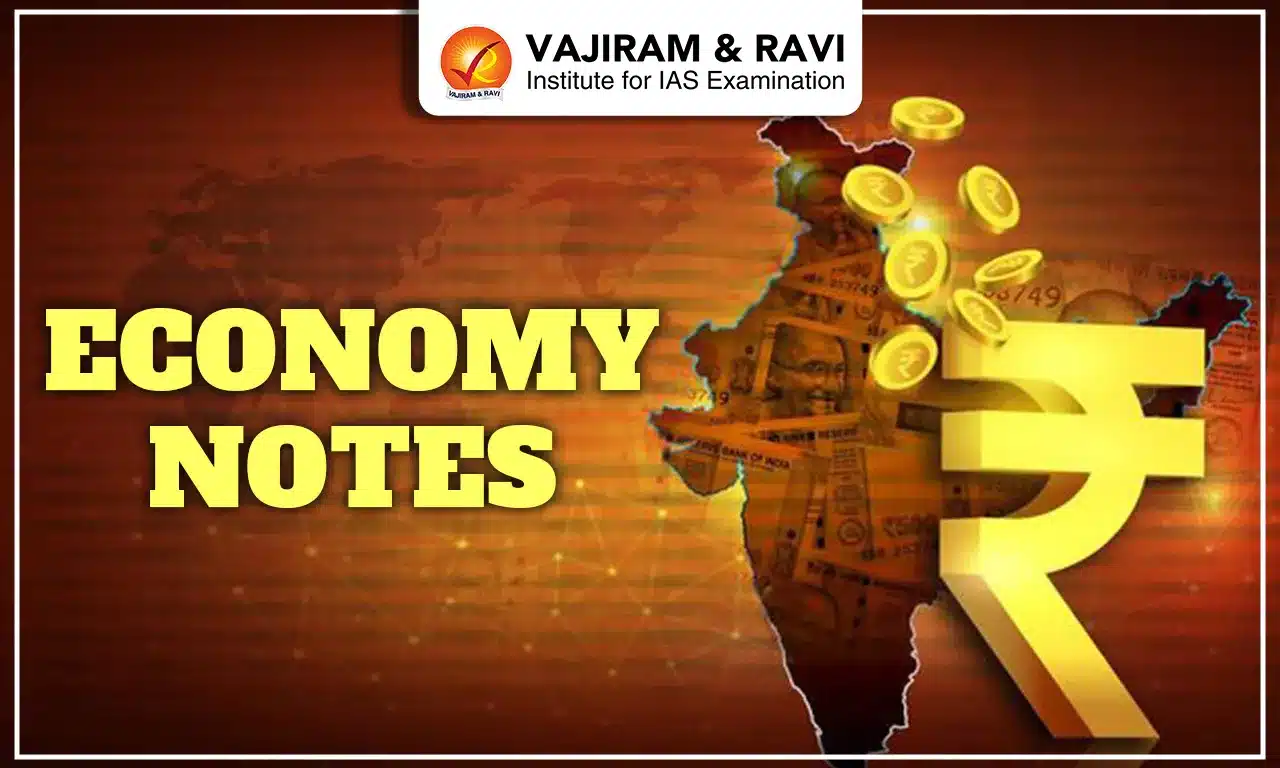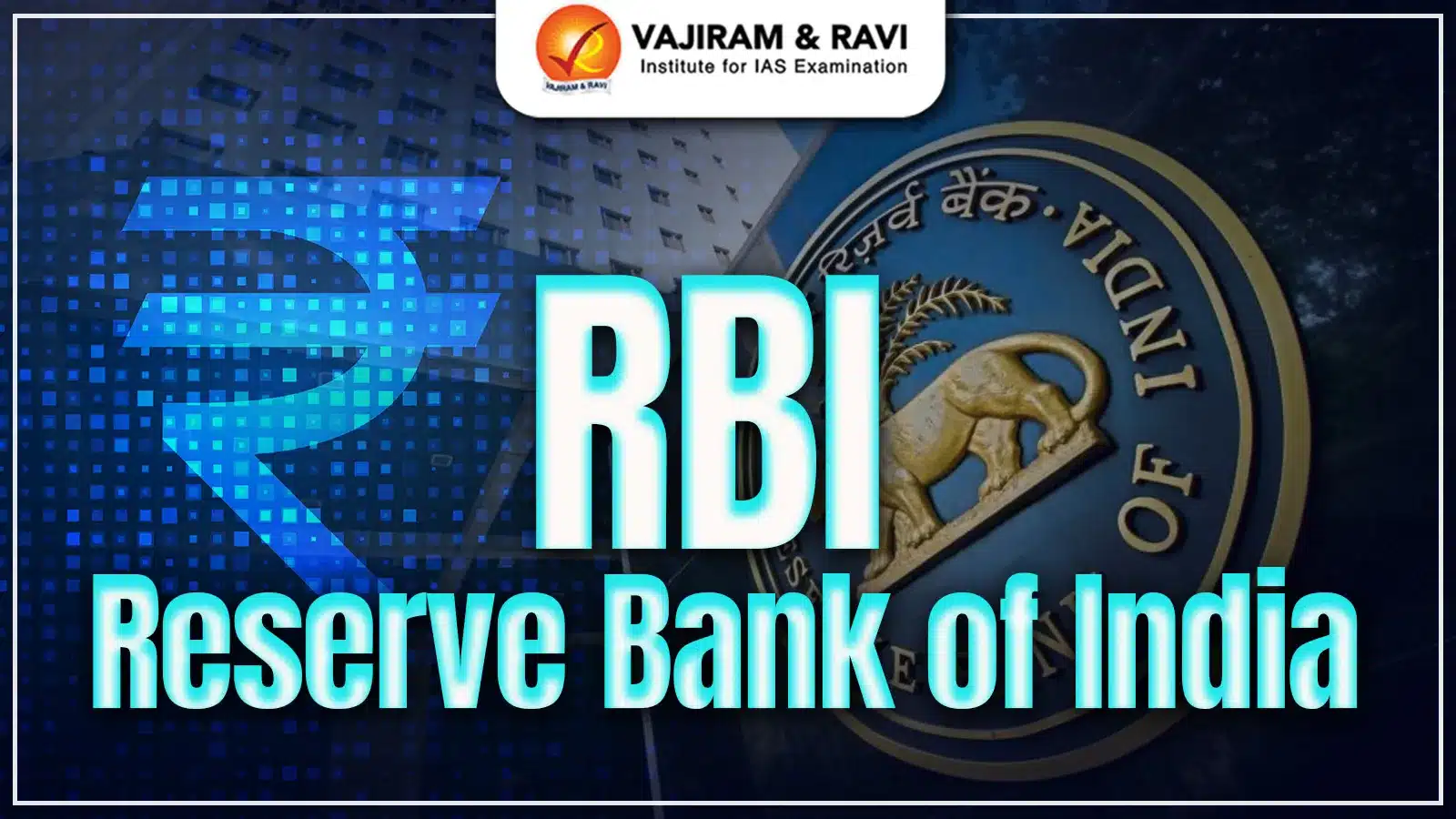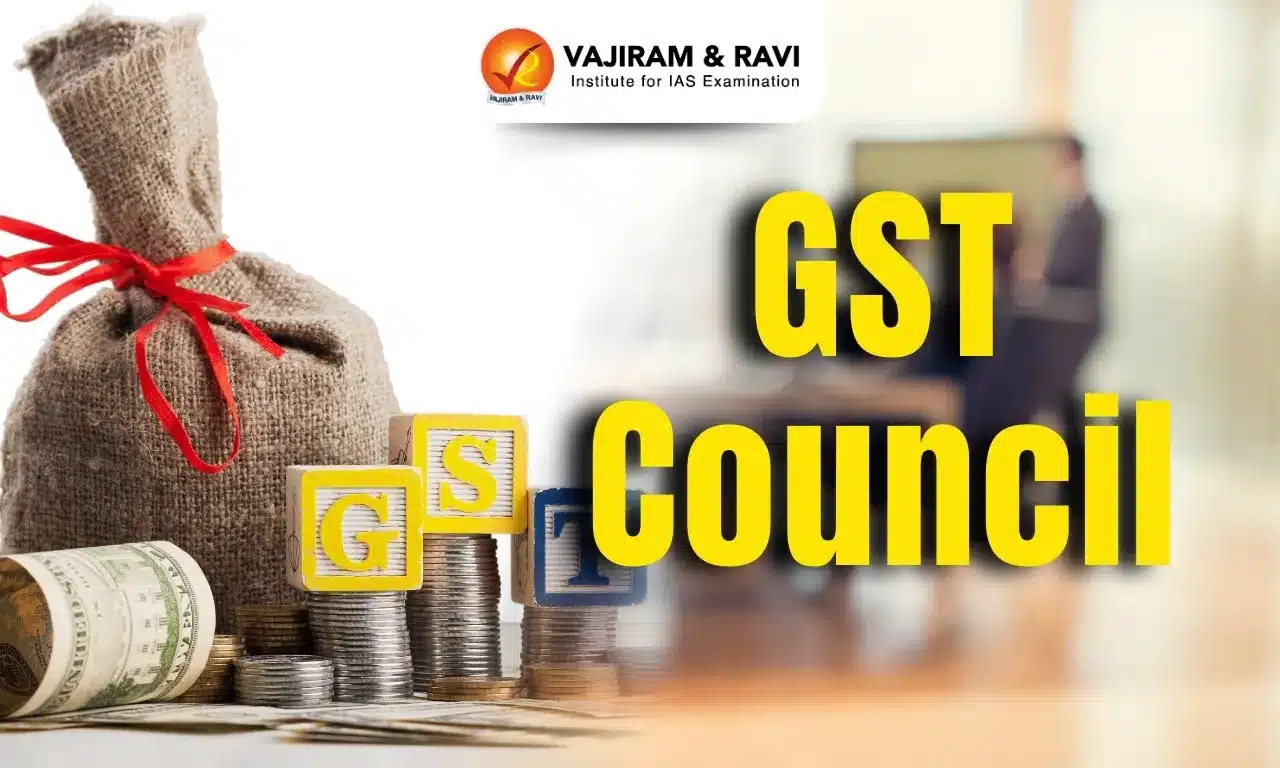Economy Notes for UPSC includes the study materials in PDF formats which includes the topics relevant to the UPSC CSE 2025. The UPSC Economy Notes includes detailed study material such as macroeconomics, microeconomics, economic development, public finance, international trade, and many more. Economy as a subject is a key component of the UPSC Syllabus 2025, appearing in both the Prelims and Mains in General Studies Paper 3.
UPSC Economy Notes
UPSC Economy Notes by Vajiram and Ravi are well organised and updated notes. Prepared by the best faculty and subject experts, the UPSC Economy Notes for UPSC covers all the important topics with easy access to the aspirant.
UPSC Economy
The questions related to Economy plays an integral role in UPSC CSE 2025 and to be equipped with updated UPSC Economy Notes keep reading the article which will help aspirants in the preparation, check out the topics mentioned in UPSC Syllabus 2025 below which are included in the Economy Notes for UPSC:
Indian Economy - Features, Structure, Current Position
The Indian economy exhibits a dynamic blend of traditional and modern sectors, emphasizing sustainable and inclusive growth. With advancements in the digital and green economies, economic reforms, and SDG alignment, India progresses toward robust global economic integration.
- Indian Economy - Features, Structure, Current Position
- Sectors of Indian Economy
- Blue Economy
- Green Economy
- Difference between Economic Growth and Development
- Sustainable Development - Importance, Features, Principles
- SDG Goals - Sustainable Development Goals
- Digital Economy
- Resource Mobilisation
- Economic Reforms in India
- LPG reforms
- New Economic Policy 1991
- Care Economy
National Income - Measurement of National Income Accounting in India
National income is a key economic indicator measured through GDP, GVA, and per capita income. India's accounting includes GDP Deflator, Green GDP for sustainability, and potential GDP to estimate future capacity, emphasizing holistic economic assessment.
- National Income - Measurement of National Income Accounting in India
- GDP - Gross Domestic Product
- GDP Deflator
- Green GDP
- Potential GDP
- GVA - Gross Value Added
- Per Capita Income
- GDP vs GVA
Capital Markets
Capital markets include equity and debt instruments like bonds, debentures, and G-secs. Specialized bonds include municipal and masala bonds. Angel investors, venture capitalists, and associated taxes like Angel Tax facilitate funding for startups and innovation.
- Capital Markets
- Bonds
- Municipal Bonds
- Masala Bonds
- Debentures
- Dated Securities
- Government Securities - G Secs
- Angel Investors
- Angel Tax
- Venture Capitalist - Venture Capital Funds
- Bonds
Equity Market - Share Market
The equity market facilitates trading in shares and securities, regulated by SEBI. It attracts FDI and FPIs for capital inflow. Key elements include IPOs, NSE, mutual funds, ETFs, and AIFs, enhancing diverse investment opportunities.
- Equity Market - Share Market
- SEBI
- Foreign Portfolio Investors - FPI
- FDI - Foreign Direct Investment
- IPO - Initial Public Offering
- NSE - National Stock Exchange
- Mutual Funds
- Alternative Investment Funds - AIF
PFRDA - Pension Fund Regulatory and Development Authority
The Pension Fund Regulatory and Development Authority (PFRDA) overseas pension schemes in India. It administers the National Pension Scheme (NPS), promoting retirement savings. The Old Pension Scheme (OPS) offers fixed pensions, while the New Pension Scheme (NPS) is market-linked and contributory.
- PFRDA - Pension Fund Regulatory and Development Authority
- National Pension Schemex
- Old Pension Scheme
- New Pension Scheme
Five Year Plan in India | Economic Planning in India
India’s Five-Year Plans (1951–2017) emphasized growth, equity, and modernization, inspired by the Harrod-Domar Model. Replaced by NITI Aayog in 2015, planning shifted to cooperative federalism, policy-driven approaches, and data-centric governance, supported by NSO statistics and budget reforms.
- Five Year Plan in India | Economic Planning in India
- Harrad Domar Model
- Planning Commission
- NITI Aayog - Objectives, Composition and Functions
- Plan and non plan expenditure
- NSO
Money and Banking
Money in India drives economic transactions, regulated by the RBI. Banking reforms address NPAs and enhance efficiency. Digital platforms like UPI and Aadhaar-enabled payments revolutionize transactions. Key policies include Monetary Policy, IBC, Payment Systems Act, and CBDC introduction.
- Money and Banking
- Money and Money Supply
- Demonetisation
- Cryptocurrency
- CBDC - Central Bank Digital Currency
- RBI - Reserve Bank of India
- Core Banking Solutions
- Banking sector - Types of Bank in India
- Non Performing Assets - NPA
- NPCI - National Payments Corporation of India
- Unified Payments Interface - UPI
- E-Rupi
- IMPS
- Payment and Settlement Systems Act 2007
- Aadhaar enabled Payment System
- Monetary Policy
- Monetary Policy Committee
- Banking sector reforms
- Insolvency and Bankruptcy Code - IBC
- NBFCs - Non Banking Financial Institutions
- Money and Money Supply
Fiscal Policy
India's fiscal policy involves government spending and revenue collection to influence the economy. It includes the Budget, managing Fiscal Deficits, and adhering to the FRBM Act. Key aspects are subsidies, off-budget borrowing, disinvestment, and promoting financial stability via FSDC.
- Fiscal Policy
- Budget - Annual Financial Statement
- Fiscal Deficit
- FRBM Act - Fiscal Responsibility and Budget Management Act 2003
- Off Budget Borrowing
- Financial Stability and Development Council - FSDC
- Disinvestment
- Subsidies
- Budget - Annual Financial Statement
Taxation in India
India's taxation system includes Direct Taxes (e.g., Income Tax) and Indirect Taxes (e.g., GST). The GST Council oversees GST implementation, including the GST Compensation Cess, ensuring revenue balance among states and the center.
- Taxation in India
- Types of Taxes - Direct and Indirect Tax
- Goods and Services Tax - GST
- GST Council
- GST Compensation Cess
Inclusive Growth - Inclusive Growth and Issues arising from it
Inclusive growth emphasizes equitable access to opportunities, reducing poverty, and ensuring social justice. Challenges include regional disparities, social inequalities, and financial exclusion. Oxfam Reports highlight wealth inequality. Financial inclusion schemes aim to bridge economic gaps effectively.
- Inclusive Growth - Inclusive Growth and Issues arising from it
- Oxfam Report
- Financial Inclusion
Inflation - Meaning and types of inflation
Inflation reflects the sustained increase in general price levels, diminishing purchasing power. Explore its types—demand-pull, cost-push, and hyperinflation—alongside core inflation, CPI, and RBI’s 4% ± 2% inflation targeting framework for UPSC insights.
- Inflation - Meaning and types of inflation
- Core Inflation
- Inflation Targeting
- Consumer Price Index- CPI
External Sector
The external sector encompasses trade, investments, and financial transactions with other countries. Understand Balance of Payment (BoP), BoP Crisis, WTO’s role, foreign trade dynamics, and policies shaping India’s global economic engagement for UPSC preparation.
- External Sector
- Balance of Payment | BoP Crisis
- WTO
- Foreign Trade
- Foreign Trade Policy
Infrastructure
Infrastructure drives economic growth and development, encompassing transportation, energy, and urban projects. Key initiatives like the National Infrastructure Pipeline and PM Gati Shakti aim to modernize and accelerate India's infrastructure transformation for a sustainable future.
- Infrastructure
- National Infrastructure Pipeline
- PM Gati Shakti
Energy Sector in India
The energy sector is vital for India's growth, focusing on sustainable and renewable sources. Explore wind energy, the Ethanol Blending Programme, biogas, Gobar Dhan Scheme, hydal energy, and the role of thermal and hydroelectric power plants in shaping India’s energy landscape.
- Energy Sector in India
- Wind Energy
- Ethanol - Ethanol Blending Programme
- Biogas
- Gobar dhan Scheme
- Hydal Energy
- Hydroelectric power plants in India
- Thermal Power Plants in India
Transport Sector in India
The transport sector is essential for economic connectivity and growth. It includes roadways, railways, airways, and waterways, driving trade and mobility. Key reforms and infrastructure projects are enhancing India’s transport network for improved efficiency and sustainability.
- Transport Sector in India
Industrial Sector of India
The industrial sector is a cornerstone of India’s economy, encompassing manufacturing and services. Key initiatives like MSME support, Pradhan Mantri MUDRA Yojana (PMMY), Make in India, and the PLI Scheme aim to boost domestic production, innovation, and global competitiveness.
- Industrial Sector of India
- MSME
- Pradhan Mantri MUDRA Yojana - PMMY
- Make in India
- PLI Scheme - Production Linked Incentive
- MSME
Employment status in india
Employment status in India is shaped by key factors like the unemployment rate and workforce participation. The Periodic Labour Force Survey (PLFS) tracks trends, while initiatives like PM SVANidhi and labour reforms aim to enhance job creation and improve working conditions.
- Employment status in india
- Unemployment Rate in India
- Periodic Labour Force Survey - PLFS
- PM SVANidhi
- Labour Reforms and Labour Code
Investment
Investment plays a crucial role in economic development, with various models facilitating growth. Explore Public-Private Partnerships (PPP), the Viability Gap Fund (VGF), and the Hybrid Annuity Model (HAM), which encourage private participation and innovation in infrastructure projects.
- Investment
- Investment Models
- Public Private Partership - PPP
- Viability Gap Fund - VGF
- Hybrid Annuity Model - HAM
- Investment Models
International Financial Institutions
International Financial Institutions (IFIs) play a pivotal role in global economic stability. The World Bank, a major IFI, provides financial and technical assistance to developing countries for projects aimed at reducing poverty and promoting sustainable development.
- International Financial Institutions
- World Bank
Last updated on December, 2025
→ Check out the latest UPSC Syllabus 2026 here.
→ Join Vajiram & Ravi’s Interview Guidance Programme for expert help to crack your final UPSC stage.
→ UPSC Mains Result 2025 is now out.
→ UPSC Notification 2026 is scheduled to be released on January 14, 2026.
→ UPSC Calendar 2026 is released on 15th May, 2025.
→ The UPSC Vacancy 2025 were released 1129, out of which 979 were for UPSC CSE and remaining 150 are for UPSC IFoS.
→ UPSC Prelims 2026 will be conducted on 24th May, 2026 & UPSC Mains 2026 will be conducted on 21st August 2026.
→ The UPSC Selection Process is of 3 stages-Prelims, Mains and Interview.
→ UPSC Result 2024 is released with latest UPSC Marksheet 2024. Check Now!
→ UPSC Prelims Result 2025 is out now for the CSE held on 25 May 2025.
→ UPSC Toppers List 2024 is released now. Shakti Dubey is UPSC AIR 1 2024 Topper.
→ UPSC Prelims Question Paper 2025 and Unofficial Prelims Answer Key 2025 are available now.
→ UPSC Mains Question Paper 2025 is out for Essay, GS 1, 2, 3 & GS 4.
→ UPSC Mains Indian Language Question Paper 2025 is now out.
→ UPSC Mains Optional Question Paper 2025 is now out.
→ Also check Best IAS Coaching in Delhi
UPSC Economy Notes FAQs
Q1. Is economy tough in UPSC?+
Q2. Who is the father of Economics?+
Q3. Who is the best teacher for UPSC Economics?+
Tags: Economics Notes Economics Notes for UPSC UPSC UPSC Economics Notes

















